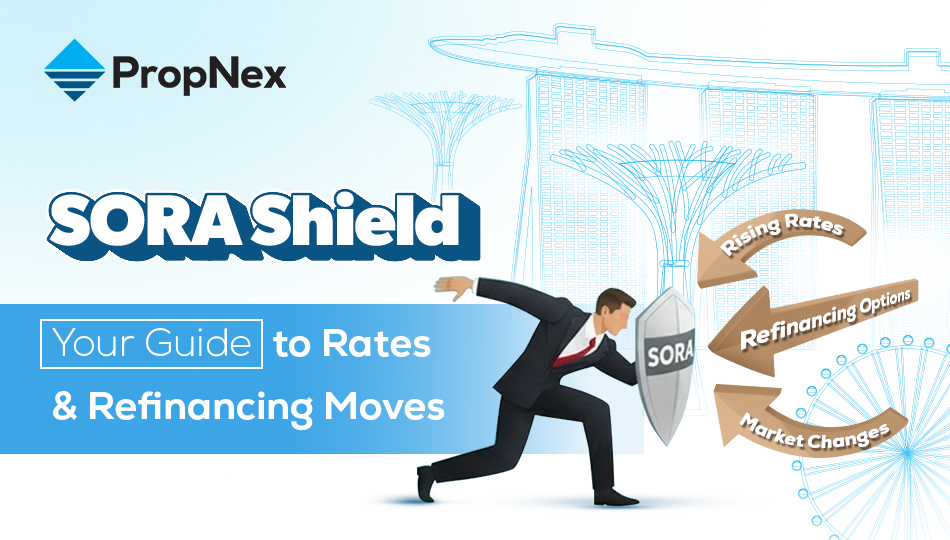PropNex Picks
|October 21,2025SORA Shield: Your Guide to Rates & Refinancing Moves
Share this article:

Mortgage rates in Singapore have been top-of-mind, and with SORA (Singapore Overnight Rate Average) now the key benchmark, homeowners need to know how it affects their monthly repayments, long-term affordability, and even their property investment decisions. The big question isn't just what will rates do next - but also how can you shield yourself from volatility and make confident financial choices?
This playbook gives you a clear roadmap with deeper insights into rate paths, refinancing strategies, and practical tools, so you can plan ahead and stay one step ahead.
What is SORA? In simple terms, it's the average interest rate that banks in Singapore charge each other when they lend money overnight - the "going rate" for short-term loans between banks.
More formally, SORA is a volume-weighted average borrowing rate in Singapore's unsecured overnight interbank SGD cash market between 8am and 6:15pm daily. It is computed using actual transactions, following international best practices under IOSCO (International Organisation of Securities Commissions) principles. Unlike the old SIBOR (Singapore Interbank Offered Rate), which relied on bank's estimates, SORA is transaction-based - making it more transparent, reliable, and less prone to sudden swings.
Banks use compounded SORA (over 1-, 3-, or 6-month periods) to price floating-rate home loans, while fixed-rate home loans are set independently by banks for specific periods. Compared to SIBOR, which was more sensitive to global credit events and could spike unexpectedly, SORA tends to move more smoothly. As financial markets worldwide shifted to transaction-based benchmarks, Singapore phased out SIBOR in favour of SORA. For borrowers, this means a benchmark that's easier to understand, more transparent, and better aligned with global best practices.
Key drivers of SORA:
Global monetary policy: The US Federal Reserve's rate decisions affect global funding closets and capital flows. When US rates rise, USD assets become more attractive, capital may flow out of Singapore, pressuring the SGD and influencing SORA.
Capital flows & global funding costs: Shifts in capital and higher global funding costs spill into SGD markets, raising interbank borrowing costs and impacting SORA.
Domestic factors & market structure: MAS actions shape SGD liquidity. Ample liquidity keeps SORA lower, while tight liquidity pushes it up. SORA's reliance on actual overnight transactions also makes it more robust than older benchmarkets like SIBOR and SOR.
Global benchmark shift: Part of an international move towards transaction-based, near risk-free benchmarks (e.g. SOFR in the US, SONIA in the UK) to ensure stability and transparency.
Market sentiment & stability: Risk sentiment in times of crisis can shift demand for SGD, influencing SORA. Forward guidance by central banks also shapes expectations and trends.
Instead of re-explaining SORA itself, it's more useful here to focus on how borrowers weigh their options between fixed packages and SORA loans.
SORA loans: Market-linked flexibility
These loans fluctuate with economic conditions, so monthly instalments can rise or fall depending on where rates move. They often come with lower initial spreads than fixed loans, making them appealing if you expect interest rates to continue easing. The trade-off is that you must be prepared for repayment amounts to increase if markets tighten again.
Fixed-rate loans: Certainty and stability
Fixed packages lock in your rate for a few years - commonly 2 to 5 - so you'll know exactly where you owe each month. This predictability is useful for households who want stability in their budgets, even if it means paying slightly more compared to today's floating packages.
Comparison at a glance
SORA-pegged loans: Lower starting costs and savings if rates fall, but repayment risk if rates rise
Fixed-rate loans: Higher initial rates, but protection from volatility and unexpected jumps
In short, floating packages suit those willing to ride market shifts, while fixed packages suit those who prefer long-term stability.
Refinancing means replacing your current mortgage with a new one that offers improved terms or suits your present financial circumstances. Many homeowners refinance to lock in lower interest rates, manage cash flow, or change the length of their loan. The process typically involves applying for a new loan - often with another bank - to pay off your existing mortgage. However, borrowers should be mindful of extra costs such as legal, administrative, and valuation fees.
How the refinancing process works
1. Explore options: Compare different banks and loan packages to identify better rates or more flexible repayment structures.
2. Apply for the new loan: Submit an application with your preferred lender and the required documents.
3. Clear the old loan: Once approved, the new lender settles your previous mortgage in full.
4. Begin new repayments: You start paying your new loan under the revised terms and tenure.
Why borrowers refinance?
Lower interest costs: Refinancing during a low-rate cycle can reduce your total interest expense.
Adjust loan tenure: Shorten the loan to clear debt faster or extend it to lighten monthly obligations.
Cash-out option: Leverage your property's equity for investment, renovation, or other financial goals.
Flexible packages: Switch to terms that better reflect your financial situation or risk appetite.
Things to consider
Lock-in period: Avoid refinancing before this ends to prevent early repayment charges.
Fees: Prepare for costs like legal, valuation, and processing fees.
Eligibility: Banks will reassess your income stability, credit record, and debt servicing ratio.
Repricing vs refinancing
Repricing: Staying with your current bank but switching to a better internal package.
Refinancing: Moving your mortgage to another bank under a new loan agreement.
Safeguarding your mortgage in a changing rate environment requires proactive management rather than reaction. Stay alert to SORA updates released by MAS and major banks, since even minor movements can affect your repayments. Regularly review your mortgage to assess how a 0.5% to 1% change in rates would impact your monthly commitments - this helps you stay financially prepared.
For example, a homeowner with a $600,000 loan could end up paying hundreds more per month if they do not refinance when interest rates drop by just half a percent. Over a year, that can amount to several thousand dollars in unnecessary interest costs - simply because many borrowers delay or avoid refinancing. Understanding this difference can be the motivation needed to act early and make the most of favourable rate conditions.
Loan Amount | Tenure | Interest Rate | Monthly Instalment |
$600,000 | 30 years | 2.5% | $2,370 |
$600,000 | 30 years | 2.0% | $2,217 |
Difference (0.5%) | - | - | $153/month or $1,836/year |
A simple 0.5% drop in interest rates can save around $150 monthly - or nearly $1,800 a year - for a typical $600,000 loan. While that might not sound like a lot, the money you save could go to other areas of your life, such as opening opportunities for living/travelling abroad.
You can also consider hybrid strategies, such as making partial prepayments when extra funds are available or opting for a shorter loan tenure to reduce total interest paid over time. Most importantly, don't wait for sharp rate increases before reviewing your options; keeping track and acting early will allow you to adjust smoothly rather than scrambling when rates shift unexpectedly.
Mr Tan and Ms Lim both took similar home loans but chose different paths - one opted for a SORA-legged floating package, while the other secured a fixed-rate plan. This allows for an easy side-by-side comparison of how each loan type performs under changing market conditions.
Case 1: Floating borrower
Mr Tan has a $600,000 loan on a 25-year tenure, pegged to the 3-month compounded SORA with a promotional spread that starts at +0.75% p.a. in the first year, +0.78% p.a. in the second, and +0.80% p.a. in the third, rising to +0.85% p.a. thereafter. Based on the current 3-month compounded SORA rate of 1.4356%, his effective interest rate for the first year works out to about 2.1856% p.a. This translates to a monthly instalment of roughly $3,050. If SORA drops by 1%, his effective rate falls to 1.38%, lowering his monthly repayment by nearly $300. Conversely, a 1% increase would push his rate to 3.28%, adding about $300 to his instalments.
3M Compounded SORA Rate | Effective Interest | Estimated Monthly Repayment |
1.43% (1st year) | 2.18% (+0.75%) | $3,050 |
1.43% (2nd year) | 2.21% (+0.78%) | $3,060 |
1.43% (3rd year) | 2.23% (+0.80%) | $3,070 |
0.43% (4th year onwards) or 2.43% (4th year onwards) | 1.28% (+0.85%) or 3.28% (+0.85%) | $2,740 or $3,370 |
This table shows how Mr Tan's repayments change as SORA fluctuates. Even a 1% increase in the benchmark rate can raise monthly payments, while a similar drop provides immediate savings. It demonstrates both the flexibility and sensitivity of floating-rate tied to SORA.
Case 2: Fixed-rate borrower
Ms Lim also has a $600,000 loan over 25 years but decided to lock in a 2-year fixed-rate package for greater stability. Under the current rate structure, her interest is fixed at 2.35% p.a. for the first two years. From the third year onward, the loan converts to a floating package tied to the 3-month compounded SORA plus a spread of +0.85% p.a.
Loan period | Interest Type | Rate Structure | Estimated Monthly Repayment |
Year 1-2 | Fixed | 2.35% p.a. | $3,180 |
Year 3 onwards | Floating | 3M compounded SORA (1.43%) + 0.85% = 2.28% p.a. | $3,080 |
Alternative scenario | Floating (Higher rate) | 3M compounded SORA (2.43%) + 0.85% = 3.28% p.a. | $3,370 |
This means that during the fixed period, her monthly instalments remain constant, no matter how the market condition or economy changes, offering predictability regardless of market changes. Once the loan transitions to a SORA-pegged rate, her repayments may fluctuate depending on how the benchmark moves. For now, the 2.35% fixed rate provides a balance of affordability and peace of mind - especially for borrowers who prefer consistency during the initial repayment years.
Summary comparison
Both borrowers started from the same point but achieved different outcomes based on their loan types. Mr Tan's SORA loan rewards flexibility and allows him to capitalise on rate cuts, while Ms Lim's fixed package ensures repayment stability in the short term and manageable adjustments later. Their examples highlight that the right choice depends on one's comfort with risk, financial objectives, and need for predictability.
The best time to opt for a fixed-rate home loan is when you expect interest rates to rise significantly over the next two to three years. In that scenario, locking in a fixed rate allows you to secure today's lower interest levels and shield yourself from higher costs later. This can result in considerable long-term savings, especially if market rates climb beyond your locked-in rate.
However, fixed-rate loans do come with trade-offs. If interest rates fall during your lock-in period, you won't benefit from the drop until that term ends. Additionally, refinancing before the fixed period is over typically incurs a prepayment penalty ranging between 0.75% and 1.5% of your outstanding loan amount. Therefore, borrowers should weigh potential savings from rate stability against the flexibility they might lose in a falling-rate environment.
Shielding yourself from interest rate swings isn't about guessing the future - it's about planning for it. By understanding SORA, following the rate path, and making timely refinancing moves, you'll stay prepared and confident.
Tip: Review your loan now, explore refinancing options, and don't wait until rates move against you.
Views expressed in this article belong to the writer(s) and do not reflect PropNex's position. No part of this content may be reproduced, distributed, transmitted, displayed, published, or broadcast in any form or by any means without the prior written consent of PropNex.
For permission to use, reproduce, or distribute any content, please contact the Corporate Communications department. PropNex reserves the right to modify or update this disclaimer at any time without prior notice.



